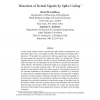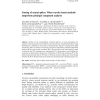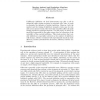ICASSP
2011
IEEE
13 years 4 months ago
2011
IEEE
Spike detection and sorting is a fundamental step in the analysis of extracellular neural recording. Here, we propose a combined spike detection-feature extraction algorithm that ...
NECO
2007
14 years 12 days ago
2007
Analog neural signals must be converted into spike trains for transmission over electrically leaky axons. This spike encoding and subsequent decoding leads to distortion. We quant...
NC
2007
14 years 12 days ago
2007
Sorting of the extracellularly recorded spikes is a basic prerequisite for analysis of the cooperative neural behavior and neural code. Fundamentally the sorting performance is deļ...
SIAMAM
2002
14 years 16 days ago
2002
The motion of a one-spike solution to a simplified form of the Gierer
JCNS
2002
14 years 17 days ago
2002
A generalized version of the integrate-and-fire model is presented that qualitatively reproduces firing rates and membrane trajectories of motoneurons. The description is based on ...
BC
1998
14 years 18 days ago
1998
Abstract. A stochastic spike train analysis technique is introduced to reveal the correlation between the ļ¬ring of the next spike and the temporal integration period of two conse...
IJON
2000
14 years 21 days ago
2000
Harmonic analysis is applied to analyze the transmission of bandlimited signals via spike trains generated by a pair of leaky integrate-and-fire (LIF) model neurons organized in a...
IJON
2006
14 years 26 days ago
2006
GABAergic inhibition via local interneurons may play a role in enhancing spike timing precision in principal cells, since it tends to eliminate the influence of initial conditions...
IJON
2006
14 years 26 days ago
2006
We discuss spike detection for noisy neuronal data. Robust spike detection techniques are especially important for probes which have fixed electrode sites that cannot be independe...
BMCBI
2008
14 years 1 months ago
2008
Background: Biological signaling pathways that govern cellular physiology form an intricate web of tightly regulated interlocking processes. Data on these regulatory networks are ...




